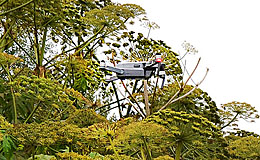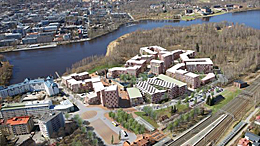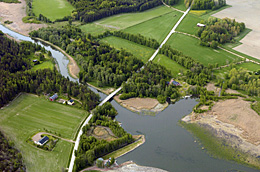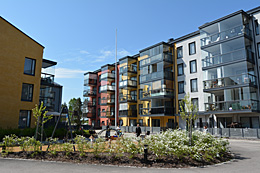Machine vision against invasive alien species

© Jari Silander
Machine vision is used to identify and map invasive alien plant species by utilising a method developed by SYKE and its partners. Many alien plant species have overrun the established native species and reduced the biological diversity. Using machine vision, it is possible to save thousands of euros when alien species are detected in time and the establishment of viable populations is prevented. Furthermore, machine learning and artificial intelligence-based support methods can be utilised for decision-making in the management of green areas, the drafting of nature
reports, in the assessment of town planning impacts and in environmental permit procedures.
In co-operation
Centre’s for Economic Development, Transport and the Environment, Vaisala Ltd.
Read more:
Promoting sustainability in urban growth

© Serum Arkkitehdit Oy
It is important to ensure that the structures of urban areas remain compact, in order to respond to climate challenges. Together with urban planners SYKE has drafted a future analysis and mapped out a decision-making path towards 2030 for 14 urban areas around Finland, aiming to help planners create cities that are more structurally compact and thereby more effective in ecological and economic terms. Well-designed urban homes and functional routes for cyclists and pedestrians are essential elements of sustainable urban living. Infill developments on brownfield sites can create new districts that also attract investment and boost the economy.
In co-operation
Urban areas of the cities of Tampere, Turku, Lahti, Pori, Kouvola, Rovaniemi, Hämeenlinna, Hyvinkää, Riihimäki, Järvenpää, Salo and Joensuu. Urban areas of Kotka–Hamina and Kokkola–Pietarsaari. Finnish Transport Agency, Ministry of the environment, The Housing Finance and Development Centre of Finland and Hypo corporation.
Read more:
A new tool for planning coastal water management activities

© Riku Lumiaro
The need to reduce nutrient loading on coastal waters can now be assessed more accurately using the new modeling tool developed at SYKE. The Coastal Load Response (CLR ) tool can specifically model coastal waters affected by the loading caused by rivers. The tool efficiently utilizes both coastal water tracking data and other data generated by water area loading and the changeover of water. The model is used to assess the reliability of the classification of coastal water conditions, and to determine the magnitude of necessary water management measures.
Read more:
Municipalities and provinces preparing for change in residential aspirations

© Anna Strandell
Using the SYKE residents’ barometer, municipalities have improved their monitoring of living and residential environments. The long-standing trend of urbanisation in residential aspirations mean that living in an apartment building near the city centre is increasingly popular and the interest in living in a detached house has decreased. The SYKE residents’ barometer has observed development in aspirations since 1998. The barometer has gained significant interest from the media and inspired further research on the subject.
In co-operation:
Ministry of the Environment
Read more:
Goals for marine environment successfully planned in Kymenlaakso

© Visa Hietalahti
The regional plan for Kymenlaakso (2014) was drawn up for the first time with consideration for marine nature. The goals of maritime transport, conservation, and tourism were brought together in the zoning plan for the sea area. Information on underwater nature – species, habitats, and geology – produced by the VELMU programme coordinated by SYKE were utilised in the zoning. The extensive VELMU surveying work supports the planning of the conservation area network and the securing of ecosystem services in Finland's coastal areas. Tanzania also utilises SYKE's know-how in developing the planning of sea areas in the Zanzibar region.
In co-operation:
Province of Kymenlaakso, partners of VELMU program.
Read more: